If you check into Aman Kyoto looking to be wowed, you will be sorely disappointed. Nothing stands out in this sprawling 24,000 sqm estate hugged by the densely forested foothills of Hidari Daimonji on one side and outlined by the gurgling Kamiyakawa River on the other. Everything blends in.
The latest addition to the Aman group, and the last Aman project in the lifetime of Kerry Hill – long-time friend and collaborator of Aman’s founder Adrian Zecha – is discreet to a fault. Hill fell in love with the gardens 20 years ago – it was he who told Zecha that this place, and this place only, shall Aman Kyoto be built, inspiring a decade-long courtship to woo the former owners of the estate – and his reverence for the space is expressed in the invisibility of the resort’s architectural design.
The low-rise units housing the restaurant, spa and rooms are uniformly clad in long strips of dark wood on the exterior, allowing them to disappear into the web of light and shadows cast through the branches of the trees. And when you step into your expansive room, there are no eye-catching elements, only floor-to-ceiling panels that run the length of the space, drawing your attention to the beauty of the foliage outside.
Apart from its generous 60 sqm size – approximately twice that of the shoebox studio units of today – the simply decorated rooms offer little hint of extravagance. Where are the branded amenities? The iconic designer furniture pieces? The perfectly composed little nooks for Instagram? For a resort with prices starting from SGD2,527 per night – breakfast not included even – it doesn’t seem to be offering much. Or does it?

A CULTURAL EXPERIENCE, CURATED
The understated luxury at Aman isn’t about ostentatious excesses. It is in the marshmallow-soft chenille bathrobes crafted by Ploh. It is in the plain-looking bathtub that perfumes the room with the calming fragrance of Hinoki wood when filled with warm water.
Outside of the rooms, luxury is expressed in finely curated experience – and we are not even talking about the exclusive, insider access Aman resorts are known for providing. Simply put, you don’t have to set foot out of the resort: the resort brings the best of Kyoto to you.
The spa offers unique rituals that lend a distinct sense of place. Think a 90-minute Aman Kyoto Signature treatment that starts with a soak in the crystalline waters of the local hot spring, known for its muscle-relaxing qualities. This is followed by a foot soak that incorporates ceremonial sake used at local shrines, imbued with 24k gold leaves; a gentle sea-salt scrub blended with detoxifying matcha powder; and a simple breathing exercise where one inhales the scent of an essential oil that evokes the mood of the season. And the deeply relaxing shiatsu massage ends with a delightful serving of freshly brewed green tea – selected by a local tea master, no less – and fine morsels of Japanese-inspired sweets, be it a tender warabi mochi dusted in matcha and given the lightest drizzle of brown sugar syrup; or a succulent wedge of fresh persimmon, served with a little square of vegan chocolate made with Kyoto spring water.
Similarly, a meal at the Living Pavilion is not just a showcase of the culinary team’s prowess, but an homage to the bounties of the region. From executive chef Kentaro Torii – whose passion for culinary exploration has taken him around the world, including a two-year stint in Singapore helming Forlino – comes an impressively wide repertoire crafted using the finest ingredients of the region, which he painstakingly sourced for months prior to the opening. A contemporary European degustation with distinct Japanese overtones might start with a light jackfish carpaccio garnished with mountain herbs, a hint of yuzu and a grating of bottarga, and climax with a thick cut of deliciously caramalised Ohmi wagyu from Shiga prefecture east of Kyoto. You might also have the opportunity to get a rare taste of exquisite hyotan pickles from a heritage producer over a traditional breakfast; taste the intensely umami soy sauce from a family brewer, located just a five-minute walk away from the resort; or savour the punchy piquant notes of sansho berries, harvested from the hills within the resort’s very own grounds.

JUST WHAT YOU NEED
Yet the biggest takeaway Aman Kyoto presents is not tangible. Sitting in a historic neighbourhood home to an artistic community some 400 years ago – that which gave rise to the Rinpa style of painting, a school characterised by its abstracted and simplified compositions – the garden has a Zen-like calm that invites even the most crowded mind to return to a state of tabula rasa. The uneven stone paths are torturous to walk on in dress shoes, but beckon you to feel the thick carpet of soft moss in between your toes. The trails in the hills might not lead to panoramic summits, but allow you to get lost while following the birdsong or the butterflies. And you might just experience the best night’s rest you’ve had in a long time, slipping into sleep while gazing at the forest-scape bathed in moonlight, while listening to the cicada’s song.
In a time when everything is vying for your attention by being bigger, brighter, louder, faster, Aman Kyoto is an antithesis. It possesses no wow-factor, yet at the end of your stay, you will be thoroughly impressed. For this is not a hotel that gives you what you want: it is a sanctuary that gives you what you need.




